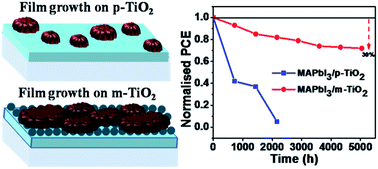Stability of MAPbI3 perovskite grown on planar and mesoporous electron-selective contact by inverse temperature crystallization†
Abstract
Single crystalline perovskite solar cells (PSC) are promising for their inherent stability due to the absence of grain boundaries. While the development of single crystals of perovskite with enhanced optoelectronic properties is known, studies on the growth, device performance and understanding of the intrinsic stability of single crystalline perovskite thin film solar cell devices fabricated on electron selective contacts are scarcely explored. In this work, we examine the impact of mesoporous TiO2 (m-TiO2) and planar TiO2 (p-TiO2) on the growth of single crystalline-methyl ammonium lead iodide (SC-MAPbI3) film, PSC device performance and film stability under harsh weather conditions (T ∼ 85 °C and RH ∼ 85%). Self-grown SC-MAPbI3 films are developed on m-TiO2 and p-TiO2 by inverse temperature crystallization under ambient conditions without the need for sophisticated glove-box processing. The best device with m-TiO2 as an electron transport layer showed a promising power conversion efficiency of 3.2% on an active area of 0.3 cm2 in hole transport material free configuration, whereas, only 0.7% was achieved for the films developed on p-TiO2. Complete conversion of precursor to perovskite phase and better surface coverage of the film leading to enhanced absorption and reduced defects of single crystalline perovskite on m-TiO2 compared to its p-TiO2 leads to this large difference in efficiency. Mesoporous device retained more than 70% of its initial performance when stored at 30 °C under dark for more than 5000 h at 50% RH; while the planar device degraded after 1500 h. Thermal and moisture endurance of SC-MAPbI3 films are investigated by subjecting them to temperatures ranging from 35 °C to 85 °C at a constant relative humidity (RH) of 85%. X-ray diffraction studies show that the SC-MAPbI3 films are stable even at 85 °C and 85% RH, with only slight detection (30–35%) of PbI2 at these conditions. This study highlights the superior stability of SC-MAPbI3 films which paves way for further studies on improving the stability and performance of the ambient processed PSCs.



 Please wait while we load your content...
Please wait while we load your content...